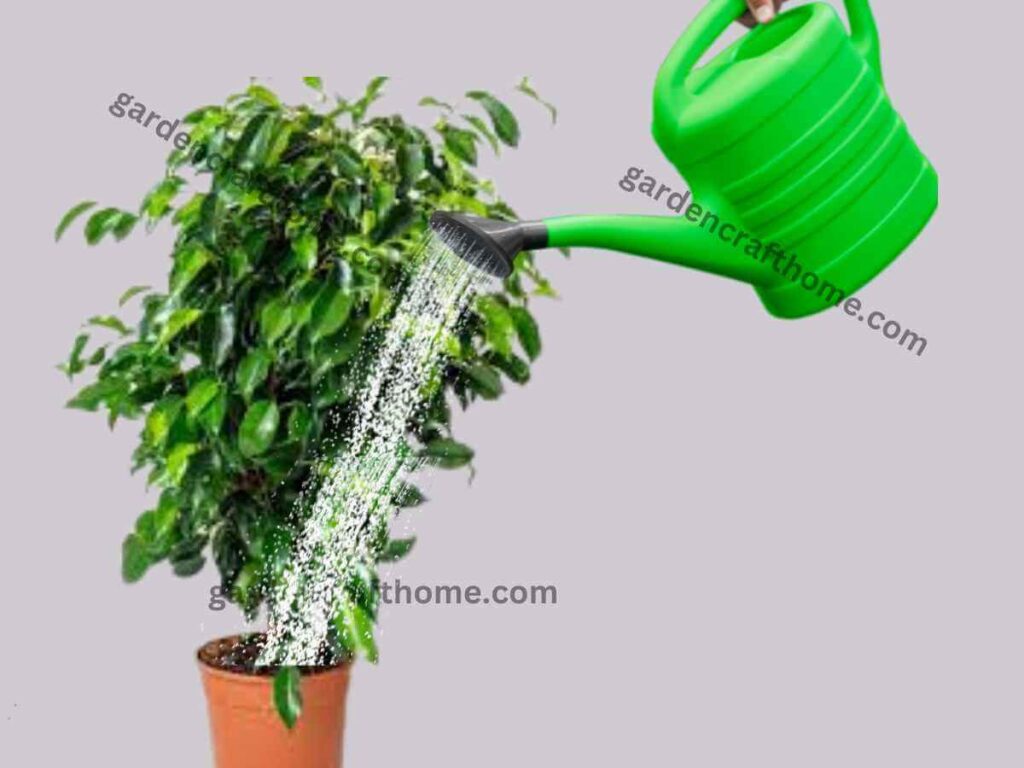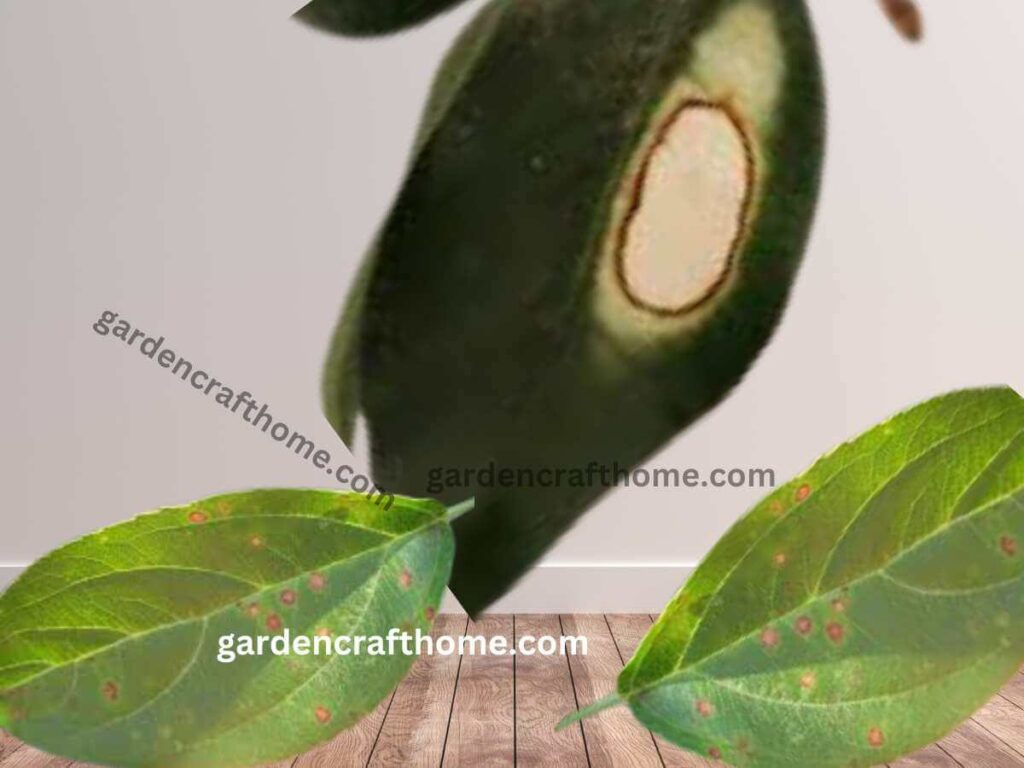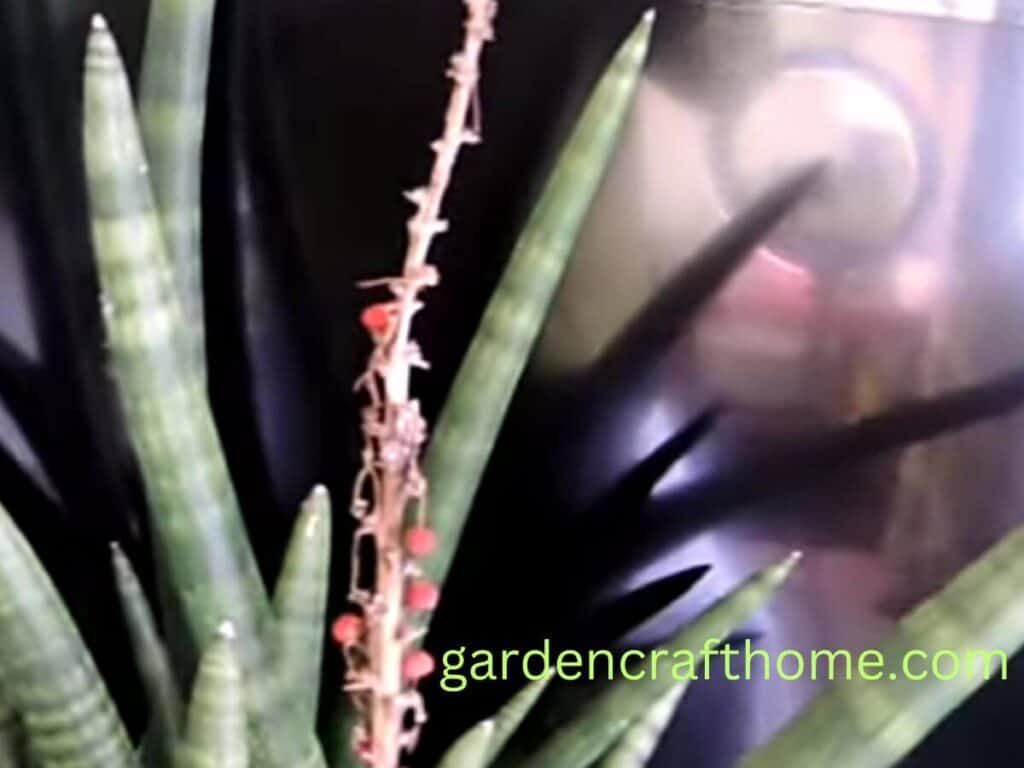How to prune Monstera we use sharp and sterilized pruning tools to remove the dead Leaves and stems, including leaves that are not wanted.
I have successfully pruned my monstera plant. Pruning your monstera plant is a nice way to keep them healthy and happy.
This article will teach you When to Prune Your Monstera Plant, How to Prune Your Monstera Plant, and Why You Should Prune Your Monstera Plant.
I will also cover related topics concerning how to prune Monstera. Are you ready to take the Challenge? Let’s go.
Also, read how to flower a monstera plant. [link]
Why Should I Prune Monstera?
let us look at the reason why pruning is important to monstera plants and why you should learn how to prune Monstera
To Control The Size And Shape Of The Monstera
One of the reasons Monstera plants are called Monstera is their outrageous size. Some can grow quickly, up to almost 30 feet outdoors and 8 feet indoors.
Fast-growing species such as Monstera Deliciosa and Monstera Adasoni cannot be kept in compact flats without being shrunk in size.
Pruning enables you to manage their quick development, keep them from getting dirty, and preserve their attractive appearance.
To Propagate A New Monstera
Another reason why Monstera is pruned is to reproduce it. When the specimen is large enough, there is also the possibility that we will have another identical plant.
Do you want a brand new Monstera plant? The truth is that it is easy to reproduce by pruning cuttings.
You can plant one by cutting the leaves of your existing Monstera below their node.
To know more about reproducing a monstera, I invite you to read my post on how to reproduce Monstera for healthy growth 👉click here now to read if you are interested. [link]
To Encourage New Growth
You can make plane cuts to make a Monstera deliciosa plant grow in the desired direction.
Removing the top encourages the plant to grow taller, while cuts on either side of the plant allow branches and leaves to spread out.
To keep your plant healthy
Pruning Monstera or trimming Monstera helps your Monstera deliciosa plant to get rid of dry, dead leaves that cannot carry out photosynthesis but still consume water and nutrients.
It would help to cut off falling leaves infested by pests and diseases to prevent them from spreading and damaging other parts.
Sometimes, seeing yellow leaves on your Monstera plant might not be an old leaf; sometimes, it results from a lack of nutrients, watering problems, sunlight issues, etc.
Seeing yellow leaves on a Monstera, I advise you to first determine the cause of the yellowing leaves before pruning.
You are not alone. I invite you to read my article about why the Monstera plant turns yellow.
This article will show you different causes and how to revive them before pruning. If you are interested, click here now to read.
To Allow The Circulation Of Light And Air
A Monstera’s excessive thickness and massive length make it difficult for light and air to reach the interior leaves or areas opposite the light source (mainly windows).
As a result, you end up with a leggy Monstera plant with long, thin stems without enough full leaves.
Additionally, tangled leaves and branches do not allow air to circulate, becoming good hiding places for pests and bacteria.
Occasionally, cutting a few leaves and stems is essential to improve light penetration and air circulation.
When To Prune Monstera
The best season to prune Monstera plants is active growing, typically in the spring when it develops new leaves and summer during the growing period.
But the best time to prune Monstera plants is Early spring as they prepare for high-growing activity.
Plants can quickly repair themselves in early spring from pruning stress or damage.
Pruning during summer is suitable for routine maintenance tasks and shaping. If you plan to propagate your Monstera by taking cuttings, summer is an excellent time for this activity.
Indoors or outdoors, plants have a natural cycle that should be continued if you want them to thrive, so know how to prune Monstera at the right time.
The right time to prune Monstera plants is near the end of their dormant period. During this time, a Swiss cheese factory does not produce much energy due to the absence of sunlight in winter.
Their growth is minimal during this time, and they need less water to stay alive.
The dormant period lasts through winter and ends in early spring when yearly temperatures slowly rise and days lengthen.
Read How To Make A Soap Dish Or Soap Holder Out Of Clay
Is It Necessary To Prune A Monstera?
Monstera is an epiphytic plant that climbs and spreads over time over other surrounding plants.
It is, therefore, necessary to prune Monstera to prevent it from invading all your furniture and having scattered shapes.
The climbs and spreads of Monstera take time, but it is better to do it regularly instead of doing severe pruning, which will stress the plant.
To limit the growth of the Monstera, you can also cut its aerial roots.
Another reason to know how to prune Monstera is to keep it healthy. Some leaves have already reached maximum development and are no longer useful to the plant.
However, they still use nutrients from the soil. This is why you must remove it. As a result, these essential elements focus on new growth.
Read What Is The Best Clay For A Pottery Wheel
How To Prune Monstera Step-By-Step
Knowing how to prune Monstera is a good idea; below, we are going to explain everything you need to know about pruning Monstera.
If you have a Monstera with vigorous growth, you have to consider pruning it.
But if it has not grown much or stopped growing, it is better not to touch it.
If you think that pruning it when it has not grown much or has stopped its growth can help it become more active, if you cut it back, it may take much longer for the plant to grow.
Pruning methods differ depending on the reason for pruning. Reshaping a Monstera is different than just cutting off a few dead leaves.
Similarly, a Monstera requires different pruning techniques to promote new growth or eliminate unhealthy plant sections.
This is a thorough tutorial on how to trim Monstera plants correctly.
Step 1: Select The Right Tools
The first step to cutting is to get all the tools and accessories necessary to carry it out.
Thick Gloves Or Gardening Gloves:
Gardening gloves are another essential item you need to have to protect yourself well. So buying some before you start is better if you don’t have them.
The reason is simple: Monstera, when you cut them, it circulates toxic sap.
Not only is this harmful to kids and pets, but it may also create issues if it touches your skin.
You will probably have skin irritation if you handle your poisonous Monstera plant without gloves.
Note: If sap gets on your hands, wash them immediately with soap and water. Therefore, it is preferable to play things safe rather than risk this.
Choose Your Pruning Tools.
Use garden shears, scissors, knives, or hand pruners to prune your Monstera.
Choosing a sharp tool is essential for making clean and precise cuts. Additionally, you can damage the plant if the tool is blunt.
A sharp tool also helps you cut large mature stems effortlessly without damaging the plant too much;
Before pruning, you should also sterilize the tool with rubbing alcohol because Monstera is prone to bacteria and other pathogens.
Saving a Monstera becomes difficult once bacteria or fungi on an unsterilized device attack your Monstera plant because they spread quickly and are difficult to treat.
You can scrub the tool with dish soap or alcohol to sterilize it. The important thing here is to make sure the tool is sharp and sterilized.
Step 2: Protect Yourself With Hand Glows
Protecting your hands when pruning is crucial because all parts of a Swiss cheese factory are toxic.
Step 3: Inspect The Plant:
You must observe the plant well and mark the cuts you want to make. Identify any yellow or damaged leaves, leggy stems, or areas you want to encourage bushier growth.
This way, you will play it safe because you will know which branches to cut, which leaves you should remove, or which stems are causing or could cause problems.
Step 4: Remove yellowed or dying leaves
Trace yellow, dying, or damaged leaves back to their branches and cut them off without cutting their main stem.
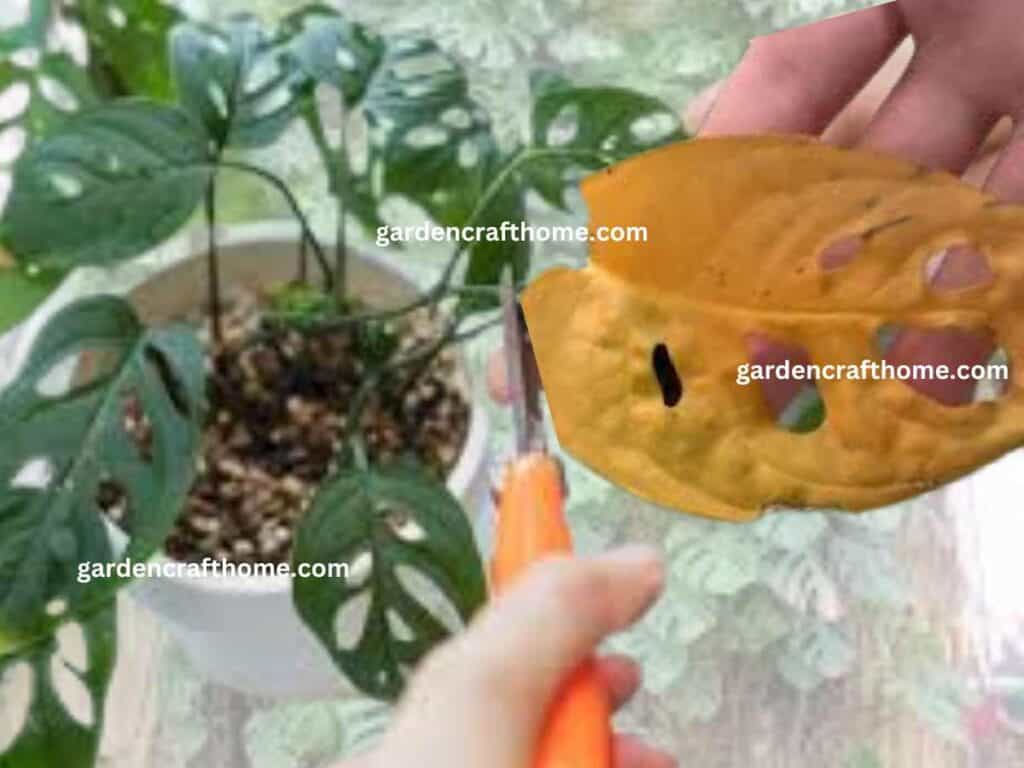
A Monstera plant kept inside may eventually lose some leaves and become yellow. This especially happens when your Monstera is old.
However, many leaves turning yellow or suddenly drying is a cause for concern, especially if your plant is not that old.
This may indicate that your plant is suffering from rot or overwatering.
In such cases, pruning the leaves could do more damage than good. You must first find the root cause and address it before pruning.
Click here to discover the cause of yellowing leaves in a montera and how to treat them.
Step 5: prune leaves to maintain shape and size to encourage growth
A Monstera plant’s present size and condition determine whether or not to prune it to manage growth and form.
- If your plant hasn’t overgrown much, you can keep it from becoming wild, Bushier, and unruly with just a few selective cuts near the parent stem (below a leaf node, where a leaf connects to the stem).
- If your Monstera is getting too large or outgrowing its space, trim the excess growth and trim back long stems near the base of the leaf stem, right below where it connects to the main stem or node.
Monstera lateral vines often get out of control due to their wild growth. Your plant will not look
attractive if you don’t trim or shape it at some point.
Keep your Monstera in nice shape by pruning off any random leaves and encouraging healthy growth in your preferred direction.
⚠️ A Big Warning: ⚠️
When you want to prune a Monstera, remember that randomly pruning too much growth can stress the plant and inhibit its growth.
Therefore, if your plant is too large, you should only cut at the base of the stems or multi-leaved branches.
A few predetermined cuts impose a lower risk of infection and damage than many cuts throughout the plant.
Final Step
Move your plans where they will receive bright light and avoid direct sunlight. Avoid watering your plants if you have water it before
Summary
You must be careful because pruning is one of the activities that stress the Monstera the most, so you have to do it without giving it too many cuts or pulling (hence, the scissors must be sharp).
Please start with the leaves and stems that are dry or weak, as well as those that are dying, because there will be no way to save them.
Of course, make sure that the Cut you give is diagonal and just below the node so that it recovers much faster.
Then you can proceed to those branches and leaves from which you want to take cuttings and, finally, those of no use or too large.
In Conclusion, As you can see, pruning Monstera does not require much science but requires patience.
You will have a good chance of succeeding without stunting its development and reaping long-term benefits if you do it correctly and avoid severe trimming.
Read How To Fertilize A Bonsai Tree
Important Mistakes to Avoid When Pruning Monstera
Pruning Monstera During The Wrong Season
If you prune toward fall, the new growth stimulated by pruning will be killed by falling temperatures.
Pruning during the growing season will interrupt your plant’s growth cycle, resulting in shock, so knowing how to prune Monstera in the right season is important.
Early spring is the best time to prune Monstera because it will quickly recover from pruning injuries once its growth spurts begin.
Pruning The Wrong Size
Any cuts you make to the plant result in open wounds. Monstera may recover quickly from these injuries but leaves your plant vulnerable to pathogens and damage.
Therefore, it is advisable to prune large Monstera plants in stages and not all at once. So, learn how to prune Monstera correctly.
Using Dirty Or Blunt Tools
You risk crushing or bruising the stems if you use blunt tools to prune them. Likewise, dirty tools expose your plants to invasions of bacteria, fungi, and parasites.
Learn how to prune Monstera with sharp and clean pruning tools. Click here to learn how to sharpen a pruning share.[link]
Size Without Lens
Pruning has various reasons, and each may require a different approach. People who want to reduce height and those who want to encourage growth will need to use entirely different techniques.
If you prune without a plan or goal, your Monstera may thrive unevenly or become stressed, so learn how to prune it with a plan.
Making Incorrect Cuts
Cutting in the wrong place, such as too close or too far from the trunk of a tree, can interfere with healing and leave the tree vulnerable to rot and disease, so learn how to prune Monstera correctly.
Pruning Monstera Root
One method for controlling and slowing the development of enormous Monstera plants is root pruning.

While it can seem stressful, doing it right will make your plant healthier. It’s also rather simple to accomplish.
Prune Lateral Roots To Slow Growth.
Lateral roots are the roots that grow inside the soil. The word lateral here refers to the fact that they usually branch from the main root stem.
Lateral roots draw water and nutrients from the soil to maintain the plant’s growth.
These roots keep spreading out until they have enough room, giving the plant the water and nutrients to form new leaves and stems.
However, it is better to slow growth by pruning the roots rather than frequently repotting the Monstera plant or leaving it root-bound.
Root-bound plants don’t have enough soil to absorb water and nutrients, so they eventually die if left untreated.
Thus, to prevent issues like root rot and stunted development, occasionally trim the roots of your Monstera.
The roots are the most fragile part of a plant, so pruning them can seem like a scary thing to do. However, cutting a few roots won’t harm the plant if you do it correctly.
Remember that it is essential to sterilize the pruning shears properly before using them. Failure to do so could result in pest attacks and diseases caused by other plants.
How To Prune Monstera Root Step By Step
Here are the root pruning steps you need to follow:
Step 1: move your plant out of its container. If the plant does not come out easily, loosen the dirt by tapping the sides of the pot or by running a butter knife around the inside edge.
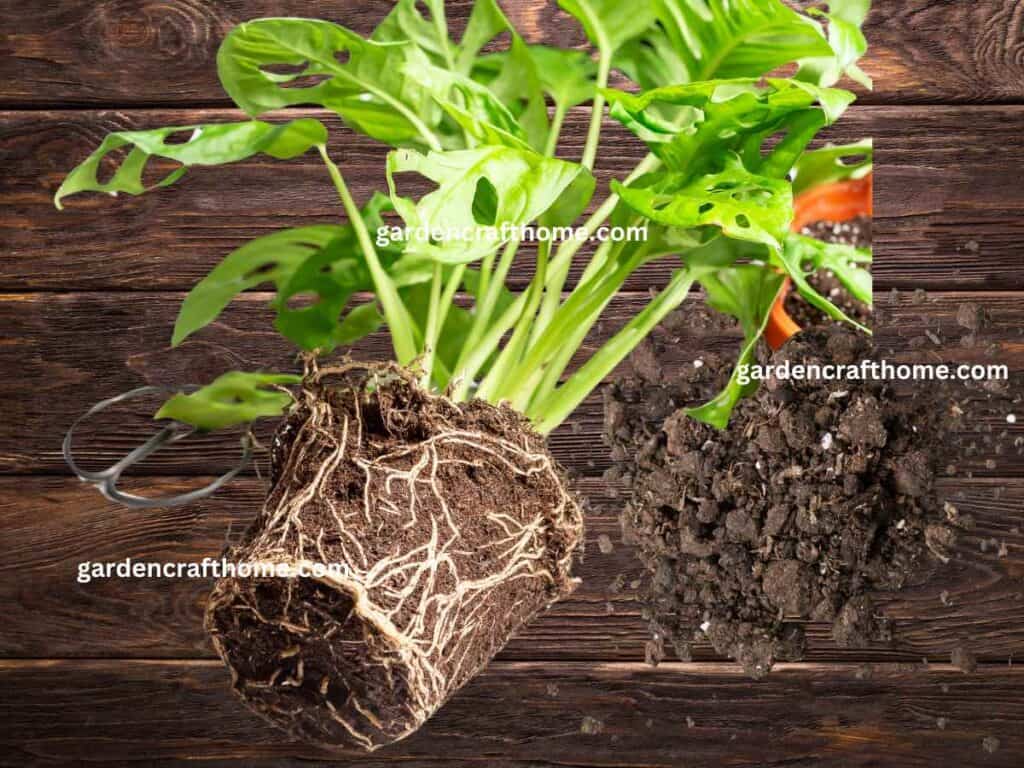
Step 2: Examine the roots for signs of damage like browning or mushy areas.
Step 3: Gently untangle the roots to make pruning easier.
Step 4: To prevent injuring the main stem root, which is bigger and thicker than the rest, cut just one-third of the overall root volume.
Step 5: Check your Monstera plant for symptoms of shock, such as wilted or yellowing leaves, then repot it in fresh soil.
To learn how to repot a Monstera, click here.[link]
Pruning Monstera Aerial Root
Aerial roots are does roots that grow above the ground to get more atmospheric nutrients and support their structural growth.
These roots are not pretty and often grow too long. I recommend not pruning the aerial roots unless necessary; Cutting them may affect the plant’s overall health.
If the aerial roots become overly long or unsightly, consider tucking them back into the soil or placing them in a decorative moss pole to encourage a more natural growth pattern.
Seeing the root brown and unhealthy might indicate overwatering or poor soil drainage.
I will address the underlying issues rather than pruning the roots in such cases.
To learn why a monstera plant is turning yellow and how to revive it, click here now.
Pruning aerial roots is the same as pruning the rest of the plant; cutting close to their stem or node is necessary without damaging it.
Be careful; crushing or bruising the stems can weaken the plant’s health, making it more susceptible to parasitic infections and diseases.
Always use clean and sharp tools when working with roots to minimize stress on the plant.
Why Should You Not Cut The Aerial Roots Of The Monstera?
Monstera aerial roots grow from the plant stem and are found outside the soil.
Monstera use their aerial roots to cling, support, and grow in trees in their natural habitat (tropical forests).
As I have said before, It is not recommended to cut these roots. The reason is simple: the roots benefit our monstera plant and allow it to grow healthily.
If you cut down these roots, you risk harming and stressing their growth.
I think it is possible to prune these roots to keep them healthy and prevent them from becoming too long or invasive only when necessary.
I recommend using clean, sharp scissors to cut the roots just above or below a node (where the stem divides into multiple branches).
Do this carefully and be careful not to hurt the plant. To learn about a Monstera Aerial Root, click here.[link]
How To Prune Monstera For Propagation
How to Prune Monstera for Propagation: If you trim the cuttings 1/2 inch below a node, you may use them to root or propagate your Monstera plant.
If you want many Monstera plants rather than just one enormous one, please put them in a brand-new pot filled with soil or water.
Growing a new plant from a portion of an existing one is called propagation. Make sure the cuttings you take from your Monstera have a node if you wish to trim it so you may create a new plant from the cuttings.
Monstera nodes are small knots in areas where Monstera leaves or aerial roots grow.
Look for a thickened area that usually forms a raised ring around the stem. Cut just below the node in this area, and plant the cutting in a transparent glass of water or moist potting mix.
The cutting will germinate into aerial roots after a while. For more grounded information concerning the propagation of the Monstera plant, click here. [link]
Frequently Asked Questions About Pruning Monstera Plants
Do Monstera Like To Be Pruned?
Yes, Monstera likes to be pruned: you can effectively maintain the growth of your Monstera by pruning unruly or excessive vines and leaves.
Pruning also promotes the growth of your plant. Pruning the vines and stems of your neglected or overgrown plant will make it look better, so learn how to prune Monstera when needed.
How Often Can I Prune Monstera?
Prune your Monstera once a year, and you should avoid pruning whenever you like; pruning two or three times a year will lead to stress and can damage your plant.
The perfect time I recommend for pruning your Monstera is early spring. The plant will enter its active growth phase in the early spring.
another time for pruning is when Monstera starts developing dry or yellowing leaves and damaged leaves,
it is acceptable to prune them at any time of the year when those signs develop so learn how to prune Monstera once a year
I always remember saying yellow or drying leaves might result in overwatering, lack of nutrients, or bad soil; I have already provided a link to learn the cause and cure.
What Leaves Should I Cut Off My Monster?
Yes, you need to remove brown or yellow leaves from your Monstera. They can no longer get photosynthesized and provide energy to your plant.
Learn how to prune Monstera yellow leaves, as brown or yellow leaves still consume water and nutrients to stay alive.
Cutting off these brown, diseased leaves frees up space and resources for new, healthy leaves.
Should I Cut The Small Leaves Off My Monstera?
You can trim your Monstera plants’ little leaves if you think they will use up much of their energy without providing much benefit to the plant.
Cutting off these few small leaves will encourage the growth of new, larger leaves. So, learn how to prune Monstera correctly.
Where Do You Cut When Pruning Monstera?
Cut off any unhealthy or expired leaves by making a cut close to the base of the stem. To control the size of your Monstera, you can prune in the same way.
Remember that pruning can encourage growth, so choose where to make your cuts.
Let’s say you wish to promote fresh development; make your cuts in the desired growth direction for the plant. Make a top cut if you want your plant to grow higher.
Suppose you want to propagate new plants from stem cuttings, cut below the node, so learn how to prune Monstera correctly.
Conclusion
Now you know how to prune Monstera, using sharp and sterilized pruning tools is important to avoid infections.
It is also important to cut the dying or yellowing leaf and stem. Remember to make a cutting near the base of their stem.
I hope this article is helpful. Please share it with your friends or on any social media network. Read How To Make A Full Garden In A Wooden Planter
more posts on Monstera; [link]


